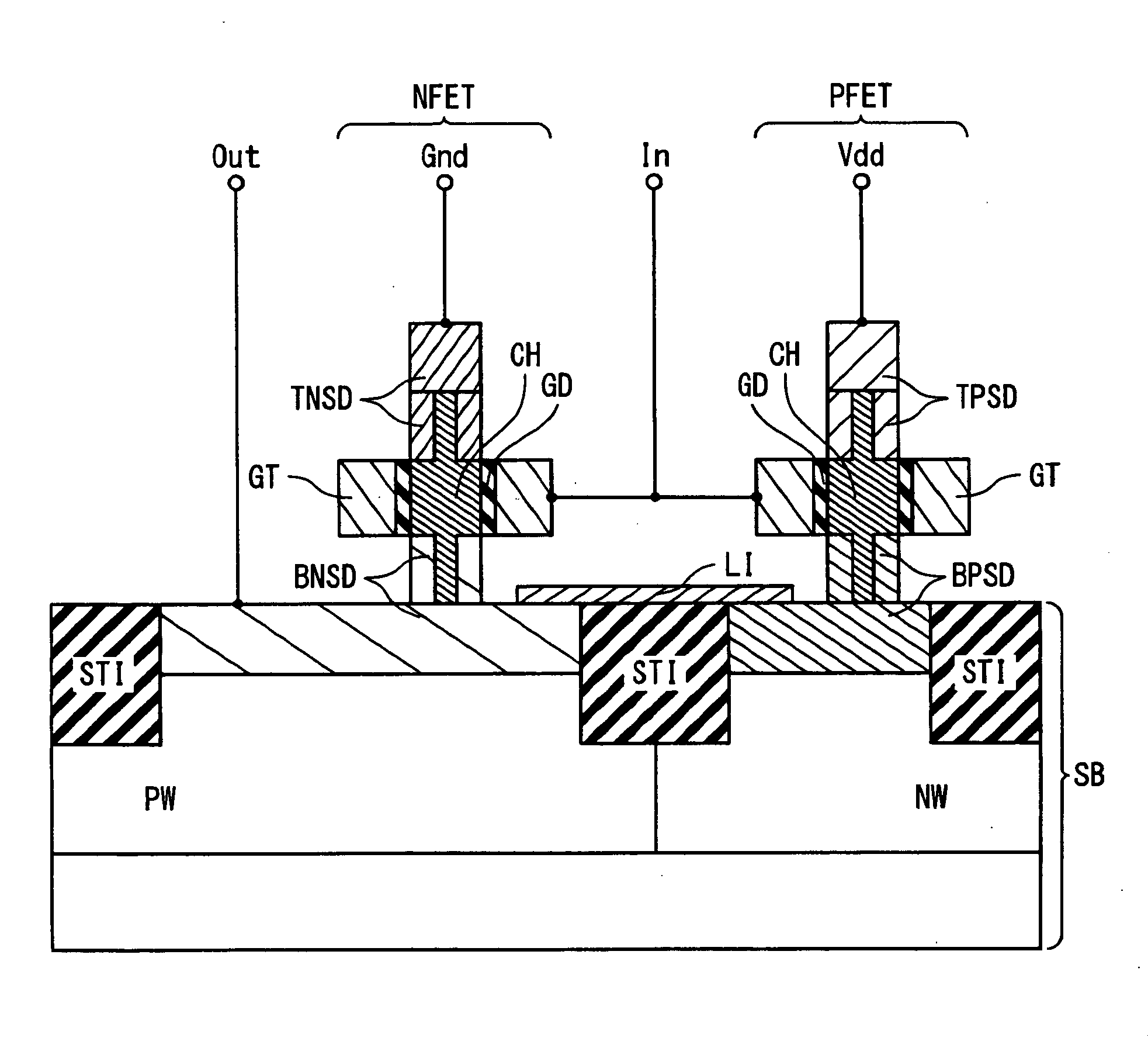Semiconductor device having vertical field effect transistor and method of manufacturing the same
- Summary
- Abstract
- Description
- Claims
- Application Information
AI Technical Summary
Benefits of technology
Problems solved by technology
Method used
Image
Examples
modification example
4. MODIFICATION EXAMPLE
4-1. First Modification Example
[0089]The pattern of the openings R1 and R2 of the alloying inhibition film 30 in FIG. 5D is not limited to that shown in FIG. 6. The pattern of the openings R1 and R2 of the alloying inhibition film 30 can be that shown in FIG. 7. In the example shown in FIG. 7, a part of the pattern of the openings R1 and R2 protrudes from a region where the semiconductor layers 21 and 22 are formed. In this case, at least a part of the sides of the formed metal layers 51 and 52 is defined in a self-aligned manner by the boundary of the semiconductor layers 21 and 22 as a base layer. Therefore, even if displacement of the openings R1 and R2 occurs, variability of shapes of the formed metal layers 51 and 52 can be suppressed. In the case where the openings R1 and R2 shown in FIG. 7 are used, a cross-sectional shape shown in FIG. 8 is obtained instead of that shown in the foregoing FIG. 5F. It should be noted that the right-side boundary of the s...
second modification example
4-2. Second Modification Example
[0090]In the actual manufacturing process, the cross-sectional shape of the metal layers 51 and 52 can be rounded shape as shown in FIG. 9 instead of strict rectangle. Even in this case, the fact remains that the first metal layer 51 is formed to be embedded in the N-type semiconductor layer 21 and the P-type semiconductor layer 22. That is, the first metal layer 51 has the first side surface 51a being in contact with the N-type semiconductor layer 21, the second side surface 51b being in contact with the P-type semiconductor layer 22, and the bottom surface 51c being in contact with both of the N-type semiconductor layer 21 and the P-type semiconductor layer 22. In order to significantly reduce the contact resistance, a buried depth LD of the first metal layer 51 is more than 5% (preferably 10%) of a width LW of the first metal layer 51. The same applies to the second metal layer 52.
[0091]Moreover, it is not necessary that upper surfaces of the metal...
third modification example
4-3. Third Modification Example
[0092]As shown in FIG. 10, the metal layers 51 and 52 may be formed to be in contact with the insulating substrate 10. In this case, the first metal layer 51 lies between the N-type semiconductor layer 21 and the P-type semiconductor layer 22. That is to say, the N-type semiconductor layer 21 and the P-type semiconductor layer 22 are electrically connected with each other through the first metal layer 51. Also in this case, there is no need to form a device isolation structure between the N-type semiconductor layer 21 and the P-type semiconductor layer 22. The N-type semiconductor layer 21 and the P-type semiconductor layer 22 are short-circuited to each other without through a device isolation structure. Therefore, the integration is improved.
[0093]In the case of the example shown in FIG. 10, the bottom surface 51c of the first metal layer 51 is in contact with the insulating substrate 10. That is, the bottom surface 51c of the first metal layer 51 is...
PUM
 Login to View More
Login to View More Abstract
Description
Claims
Application Information
 Login to View More
Login to View More - R&D
- Intellectual Property
- Life Sciences
- Materials
- Tech Scout
- Unparalleled Data Quality
- Higher Quality Content
- 60% Fewer Hallucinations
Browse by: Latest US Patents, China's latest patents, Technical Efficacy Thesaurus, Application Domain, Technology Topic, Popular Technical Reports.
© 2025 PatSnap. All rights reserved.Legal|Privacy policy|Modern Slavery Act Transparency Statement|Sitemap|About US| Contact US: help@patsnap.com



